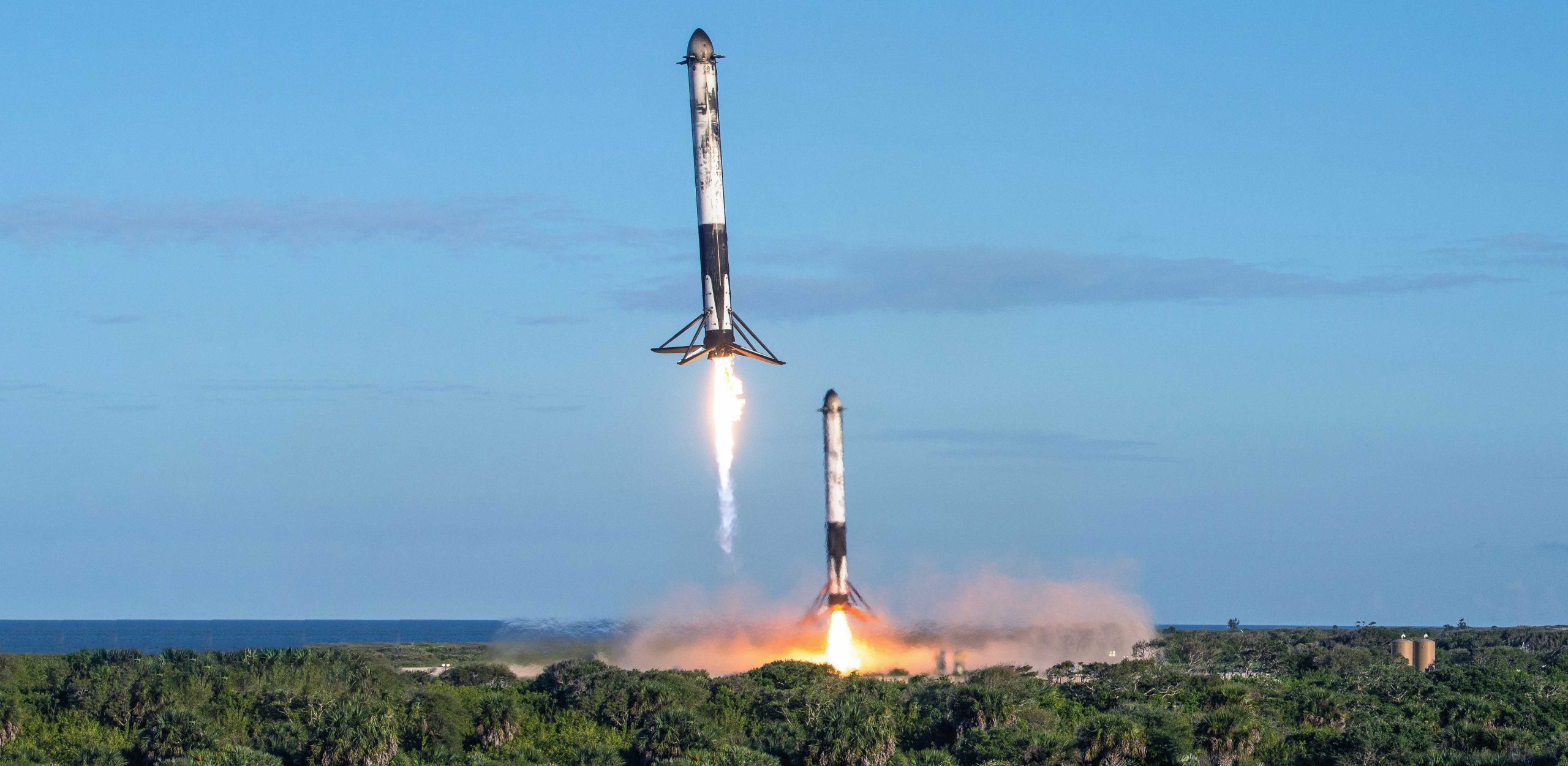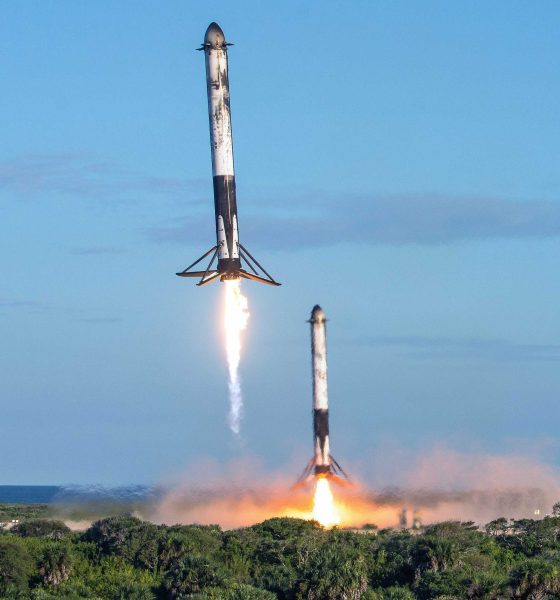

SpaceX
SpaceX’s third Falcon Heavy launch is just one month away
SpaceX is exactly one month away from Falcon Heavy’s next scheduled launch, an important mission for the US Air Force known as Space Test Program 2 (STP-2). Carrying 24 satellites of various sizes, Falcon Heavy is scheduled to lift off for the third time as early as June 22nd.
In support of the mission, SpaceX will need to completely integrate Falcon Heavy and prepare the rocket for a routine static fire test approximately one week prior to launch, sometime in mid-June. STP-2 will be critical to both SpaceX and the USAF for a number of reasons, ranging from rocket reusability to the future of US military launch procurement.
ICYMI: LightSail 2 is set to launch next month aboard a #SpaceX Falcon Heavy! Our citizen-funded solar sail is officially scheduled to lift off on 22 June 2019: https://t.co/J2AC5JQ1Kr pic.twitter.com/lC1MJoeh3C— Planetary Society (@exploreplanets) May 21, 2019
Rapid Falcon Heavy reuse
From a technological standpoint, Falcon Heavy Flight 3 will be a milestone in large part due to its reuse of two Falcon Heavy side boosters, previously flown on April 11th as part of Falcon Heavy’s Arabsat 6A commercial launch debut. Around eight minutes after launching the ~6450 kg (14,200 lb) satellite on its way to an exceptionally high transfer orbit of 90,000 km (56,000 mi), side boosters B1052 and B1053 completed flawless landings at LZ-1 and LZ-2.
Both boosters were quickly ‘broken over’ (brought horizontal) and transported to Pad 39A’s main hangar for inspection and refurbishment. Relative to almost all other Block 5 boosters, Falcon Heavy Flight 2’s side boosters were subjected to a uniquely gentle reentry thanks to a lower velocity stage separation. As such, they should be easier to turn around than most, but given that the boosters are also acting as partial pathfinders for the reuse of actual Falcon Heavy hardware, they are unlikely to break any records.
Sadly, the first Falcon Heavy Block 5 center core – B1055 – was toppled in high seas while still aboard drone ship Of Course I Still Love You (OCISLY), cutting short any possibility of future reuses of the thoroughly scorched booster. For unknown reasons, be it an unrelated USAF requirement or SpaceX simply choosing caution, plans already accounted for a new center core flying on STP-2, although both Arabsat 6A side boosters were to be reused. Believed to be B1057, that new Falcon Heavy center core completed its Texas acceptance testing in late April and shipped to Cape Canaveral, Florida soon after.
An Air Force first
Aside from offering a chance for SpaceX to tie its 72-day Falcon 9 turnaround record twice, STP-2 has unexpectedly become a keystone of the US military’s interest in certifying flight-proven rockets for military launches. The USAF has described the reuse of Falcon Heavy boosters on STP-2 as a step forward for all future reusable launch vehicles, but the reality is that SpaceX is and will remain the only player in town until 2022 at the earliest. The next closest entrant – Blue Origin’s New Glenn rocket – is unlikely to be ready for its launch debut before late ’21 or early ’22. ULA’s “SMART” reuse of Vulcan rocket engine sections is unlikely to be ready before the mid-2020s, likely 2024-2026.
SpaceX, however, has already reused Falcon 9 boosters more than 20 times on orbital-class missions, and the frequency of reuse is only likely to increase with the introduction of the final major Falcon 9 and Heavy upgrade, known as Block 5. Designed with a nominal lifespan of 10+ launches, each booster can support a huge number of missions and also offers the potential to dramatically reduce launch costs down the road. Additionally, as noted by VP of Launch Reliability Hans Koenigsmann, SpaceX firmly believes that reliability will come hand in hand with routine reuse, as each recovered booster can serve as a treasure trove of data. Thanks to reusability, SpaceX can fill recoverable boosters to the brim with cameras and gather full-resolution telemetry otherwise inaccessible for an expendable rocket.

The matter of launch costs is not a particularly significant concern of the US military, mainly a consequence of the incredibly disproportionate relationship between the cost of launch and the cost the military satellite payloads. An excellent example of this disparity can be found in SpaceX’s December 2018 launch of the USAF’s first GPS III satellite: SpaceX’s launch contract cost $82M, while the Lockheed Martin-built spacecraft aboard cost no less than ~$600M.
However, reusable rockets are quite plainly the future of space launch, evidenced by SpaceX’s meteoric rise and rapid cannibalization of the global commercial launch market. As a partial result, the survival of ULA – a Lockheed Martin-Boeing cooperative that builds the Delta IV and Atlas V rockets – is almost completely dependent upon military development and launch contracts. Blue Origin, however, is now offering the promise of an independently stable launch provider thanks to continual funding from owner Jeff Bezos, and reusability will be an absolute necessity if its massive New Glenn rocket is to succeed.

In short, the USAF is faced with a simple proposition: get behind reusable rockets or risk falling behind. SpaceX is more than happy to ease the conservative military branch into the new era, and Falcon Heavy’s STP-2 launch will be a major step in the right direction. Thanks to its reuse of two side boosters, Air Force officials will be able to observe the process of rapid refurbishment firsthand, providing information they will then use to develop certification requirements for flight-proven rockets. More generally, STP-2 will also act as a dedicated demonstration that SpaceX and the USAF will use to fully certify Falcon Heavy for military launches, hopefully ending Delta IV Heavy’s decade-long monopoly over military heavy lift.
Check out Teslarati’s Marketplace! We offer Tesla accessories, including for the Tesla Cybertruck and Tesla Model 3.

Elon Musk
Starlink achieves major milestones in 2025 progress report
Starlink wrapped up 2025 with impressive growth, adding more than 4.6 million new active customers and expanding service to 35 additional countries, territories, and markets.

Starlink wrapped up 2025 with impressive growth, adding more than 4.6 million new active customers and expanding service to 35 additional countries, territories, and markets. The company also completed deployment of its first-generation Direct to Cell constellation, launching over 650 satellites in just 18 months to enable cellular connectivity.
SpaceX highlighted Starlink’s impressive 2025 progress in an extensive report.
Key achievements from Starlink’s 2025 Progress
Starlink connected over 4.6 million new customers with high-speed internet while bringing service to 35 more regions worldwide in 2025. Starlink is now connecting 9.2 million people worldwide. The service achieved this just weeks after hitting its 8 million customer milestone.
Starlink is now available in 155 markets, including areas that are unreachable by traditional ISPs. As per SpaceX, Starlink has also provided over 21 million airline passengers and 20 million cruise passengers with reliable high-speed internet connectivity during their travels.
Starlink Direct to Cell
Starlink’s Direct to Cell constellation, more than 650 satellites strong, has already connected over 12 million people at least once, marking a breakthrough in global mobile coverage.
Starlink Direct to Cell is currently rolled out to 22 countries and 6 continents, with over 6 million monthly customers. Starlink Direct to Cell also has 27 MNO partners to date.
“This year, SpaceX completed deployment of the first generation of the Starlink Direct to Cell constellation, with more than 650 satellites launched to low-Earth orbit in just 18 months. Starlink Direct to Cell has connected more than 12 million people, and counting, at least once, providing life-saving connectivity when people need it most,” SpaceX wrote.
Elon Musk
Starlink passes 9 million active customers just weeks after hitting 8 million
The milestone highlights the accelerating growth of Starlink, which has now been adding over 20,000 new users per day.

SpaceX’s Starlink satellite internet service has continued its rapid global expansion, surpassing 9 million active customers just weeks after crossing the 8 million mark.
The milestone highlights the accelerating growth of Starlink, which has now been adding over 20,000 new users per day.
9 million customers
In a post on X, SpaceX stated that Starlink now serves over 9 million active users across 155 countries, territories, and markets. The company reached 8 million customers in early November, meaning it added roughly 1 million subscribers in under seven weeks, or about 21,275 new users on average per day.
“Starlink is connecting more than 9M active customers with high-speed internet across 155 countries, territories, and many other markets,” Starlink wrote in a post on its official X account. SpaceX President Gwynne Shotwell also celebrated the milestone on X. “A huge thank you to all of our customers and congrats to the Starlink team for such an incredible product,” she wrote.
That growth rate reflects both rising demand for broadband in underserved regions and Starlink’s expanding satellite constellation, which now includes more than 9,000 low-Earth-orbit satellites designed to deliver high-speed, low-latency internet worldwide.
Starlink’s momentum
Starlink’s momentum has been building up. SpaceX reported 4.6 million Starlink customers in December 2024, followed by 7 million by August 2025, and 8 million customers in November. Independent data also suggests Starlink usage is rising sharply, with Cloudflare reporting that global web traffic from Starlink users more than doubled in 2025, as noted in an Insider report.
Starlink’s momentum is increasingly tied to SpaceX’s broader financial outlook. Elon Musk has said the satellite network is “by far” the company’s largest revenue driver, and reports suggest SpaceX may be positioning itself for an initial public offering as soon as next year, with valuations estimated as high as $1.5 trillion. Musk has also suggested in the past that Starlink could have its own IPO in the future.
News
SpaceX shades airline for seeking contract with Amazon’s Starlink rival

SpaceX employees, including its CEO Elon Musk, shaded American Airlines on social media this past weekend due to the company’s reported talks with Amazon’s Starlink rival, Leo.
Starlink has been adopted by several airlines, including United Airlines, Qatar Airways, Hawaiian Airlines, WestJet, Air France, airBaltic, and others. It has gained notoriety as an extremely solid, dependable, and reliable option for airline travel, as traditional options frequently cause users to lose connection to the internet.
Many airlines have made the switch, while others continue to mull the options available to them. American Airlines is one of them.
A report from Bloomberg indicates the airline is thinking of going with a Starlink rival owned by Amazon, called Leo. It was previously referred to as Project Kuiper.
American CEO Robert Isom said (via Bloomberg):
“While there’s Starlink, there are other low-Earth-orbit satellite opportunities that we can look at. We’re making sure that American is going to have what our customers need.”
Isom also said American has been in touch with Amazon about installing Leo on its aircraft, but he would not reveal the status of any discussions with the company.
The report caught the attention of Michael Nicolls, the Vice President of Starlink Engineering at SpaceX, who said:
“Only fly on airlines with good connectivity… and only one source of good connectivity at the moment…”
CEO Elon Musk replied to Nicolls by stating that American Airlines risks losing “a lot of customers if their connectivity solution fails.”
American Airlines will lose a lot of customers if their connectivity solution fails
— Elon Musk (@elonmusk) December 14, 2025
There are over 8,000 Starlink satellites in orbit currently, offering internet coverage in over 150 countries and territories globally. SpaceX expands its array of satellites nearly every week with launches from California and Florida, aiming to offer internet access to everyone across the globe.
Currently, the company is focusing on expanding into new markets, such as Africa and Asia.








